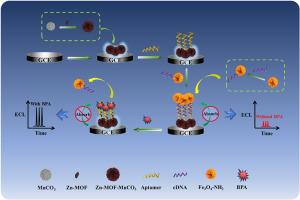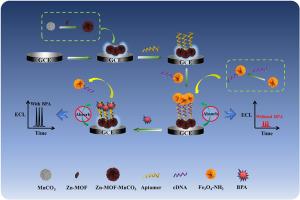2D Zn-based metal-organic framework as an efficient electrochemiluminescence emitter: A novel inner filter effect-based ECL biosensor for trace detection of bisphenol A
IF 6
2区 化学
Q1 CHEMISTRY, ANALYTICAL
引用次数: 0
Abstract
The potential hazards of bisphenol A (BPA) to the environment have become a global concern. Herein, 2D Zn-based metal-organic framework nanosheet (2D Zn-MOF) and MnCO3 nanocomposite (Zn-MOF-MnCO3), an efficient electrochemiluminescence (ECL) probe was first synthesized and constructed for trace detection of BPA. Owing to the elimination of the aggregation-induced quenching (ACQ) effect of polycyclic aromatic hydrocarbons (PAHs), the leaf-like Zn-MOF exhibited a satisfactory ECL signal. The MnCO3, which has excellent biocompatibility, showed excellent ECL efficiency in the presence of K2S2O8. With the covalent binding of Zn-MOF and MnCO3, we demonstrated that the ECL intensity and stability of Zn-MOF-MnCO3 improved significantly. In addition, the inner filter effect (IFE) of Fe3O4–NH2 NPs toward Zn-MOF-MnCO3 had been confirmed to be the ECL quenching mechanism. Based on above strategies, the proposed ECL-IFE biosensor exhibited a trace detection ability of BPA in a wide linear range (10 fM ∼ 10 μM) with a low detection limit (4.2 fM). Further in-depth study confirmed the excellent repeatability, selectivity, and stability of sensors, which provided a fresh sensing platform for trace detection of BPA in the environment.


二维锌基金属有机框架作为高效电化学发光发射器:基于内滤波效应的新型 ECL 生物传感器,用于痕量检测双酚 A
双酚 A(BPA)对环境的潜在危害已成为全球关注的问题。本文首次合成并构建了二维锌基金属有机框架纳米片(2D Zn-MOF)和 MnCO3 纳米复合材料(Zn-MOF-MnCO3)--一种用于痕量检测双酚 A 的高效电化学发光(ECL)探针。由于消除了多环芳烃(PAHs)的聚集诱导淬灭(ACQ)效应,叶状 Zn-MOF 显示出令人满意的 ECL 信号。具有良好生物相容性的 MnCO3 在 K2S2O8 的存在下表现出卓越的 ECL 效能。通过 Zn-MOF 和 MnCO3 的共价结合,我们证明 Zn-MOF-MnCO3 的 ECL 强度和稳定性都有显著提高。此外,Fe3O4-NH2 NPs 对 Zn-MOF-MnCO3 的内滤效应(IFE)也被证实是 ECL 的淬灭机制。基于上述策略,所提出的 ECL-IFE 生物传感器在较宽的线性范围(10 fM ∼ 10 μM)内对双酚 A 具有痕量检测能力,检测限低(4.2 fM)。进一步的深入研究证实了传感器具有良好的重复性、选择性和稳定性,为环境中双酚 A 的痕量检测提供了一个全新的传感平台。
本文章由计算机程序翻译,如有差异,请以英文原文为准。
求助全文
约1分钟内获得全文
求助全文
来源期刊

Analytica Chimica Acta
化学-分析化学
CiteScore
10.40
自引率
6.50%
发文量
1081
审稿时长
38 days
期刊介绍:
Analytica Chimica Acta has an open access mirror journal Analytica Chimica Acta: X, sharing the same aims and scope, editorial team, submission system and rigorous peer review.
Analytica Chimica Acta provides a forum for the rapid publication of original research, and critical, comprehensive reviews dealing with all aspects of fundamental and applied modern analytical chemistry. The journal welcomes the submission of research papers which report studies concerning the development of new and significant analytical methodologies. In determining the suitability of submitted articles for publication, particular scrutiny will be placed on the degree of novelty and impact of the research and the extent to which it adds to the existing body of knowledge in analytical chemistry.
 求助内容:
求助内容: 应助结果提醒方式:
应助结果提醒方式:


